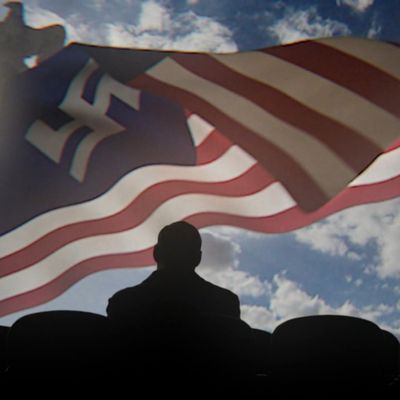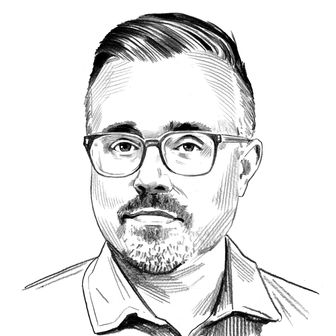
Amazon’s most ambitious drama begins with this clever episode, designed to introduce viewers to an alternative universe where Axis powers won World War II. Based on Philip K. Dick’s 1962 Hugo Award–winning book, The Man in the High Castle is exactly the kind of challenging, enterprising show that Amazon needs. Last January, Matt Zoller Seitz wrote that the show “simultaneously evokes House of Cards and Mad Men.” Transparent put Amazon Studios on the map, but this drama confirms that the streaming service won’t be a one-hit wonder.
What if the Allies didn’t win World War II? This tremendously fruitful question lies at the core of The Man in the High Castle. After bombing Washington D.C. to end the war, Nazi Germany and Imperial Japan jointly occupy the United States, splitting it in half. The Japanese Pacific States consist of everything west of the Rocky Mountains; the Greater Nazi Reich comprises the land east of the range. The Rockies are a relatively lawless neutral zone, trapped between the two superpowers. It’s been over a decade since World War II ended, long enough for German and Japanese culture to impact their respective colonies — and long enough for a small force of rebels to build steam.
In this alternative universe, we meet a series of characters defined across three categories: the Nazis, the Japanese, and the Resistance. Of course, some characters will cross (and double-cross) those lines. Take Joe Blake (Luke Kleintank), whom we meet in a movie theater watching The Punch Party, a fictional film starring Rock Hudson and June Allyson, before he steps into a Times Square dominated by a Nazi flag. Almost immediately, a gauntlet is thrown down: The Man in the High Castle stakes its claim for some of the best production design on TV, finding subtle ways to inject both Nazi and Japanese influences into the buildings, clothing, and culture.
Back to Joe. He’s given a card at the screening, then told to meet the leader of the Resistance, a man named Mr. Warren (played by character actor Michael Rispoli). Mr. Warren puts young Joe through the paces — will he be loyal, or is he a spy? — and after Joe says the right answers, Warren makes him a driver. He’s ordered to take a truck across the Reich into the neutral zone, then wait for a contact who will approach once it’s safe. And, no matter what happens, Joe shouldn’t look at the cargo; as far as he knows, he’s just hauling good old German coffee makers. As he leaves, Nazi soldiers raid the Resistance’s hiding place. He barely escapes in the truck, just as Warren is arrested by an instantly nefarious SS officer named Obergruppenführer Smith (Rufus Sewell, an actor who can be menacing with just a glare).
On the other side of the continent, we meet Juliana Crain (Alexa Davalos) as she studies aikido. This is a beautiful consequence of an occupying force’s culture, not a violent one. San Francisco is markedly different from New York, both in style and in tone, as the Japanese influences have taken hold. We also meet Trudy (Conor Leslie), Juliana’s half-sister. She’s back in town but doesn’t plan to stay, telling sis that she’s found purpose in a new job. We briefly meet Juliana’s parents: a mother who doesn’t approve of her interest in Japanese culture, and a more supportive stepfather.
Most importantly, we’re introduced to Juliana’s boyfriend, Frank Frink (Rupert Evans). They seem like a happy couple; he sketches a drawing of her, she encourages him to work more on his art. They talk about having kids, but Juliana is reticent because Frank’s grandfather was a Jew. What if someone found out? Would their child ever be safe? At a neighborhood sake bar, we also meet Frank’s friend Ed McCarthy (DJ Qualls), who works with him at a gun factory.
Later that night, Trudy runs into Juliana again, handing her a package before she’s shot in the street by Japanese soldiers. Davalos, a surprisingly flat actress in this episode, underplays the emotion of the scene. (Thankfully, she gets better as the show goes along.) Despite that tonal misstep, though, what a great noir setup! The woman in the shadows literally hands Juliana something that changes her life. Dashiell Hammett would have approved.
The Maltese Falcon of this setup is The Grasshopper Lies Heavy, actual newsreel footage from the real end of World War II, an artifact that shouldn’t exist within the show’s timeline. What is it? Did the Allies really win the war? It’s allegedly produced by a mysterious figure known as “the Man in the High Castle,” who wants to show the world the way it could be — or the way it was before the truth was covered up. Juliana also discovers that Trudy had a bus ticket for Canon City, Colorado, along with a note that lists the name of a diner and a time. She decides to go in her place, tells Frank that she’s going to the cops, but leaves behind her locket to let him know that she’s taking up her sister’s cause.
After an Indiana Jones–inspired map illustrates Joe’s drive across the Reich, he blows out a truck tire. A cop comes to help, asking for his transit papers. The next scene is creepy in the most unexpected way, setting the tone for how far The Man in the High Castle is willing to go: Joe and the cop noticed ash falling from the sky, just as it did near concentration camps during the Holocaust. A nearby hospital burns cripples and the terminally ill every Tuesday.
We meet Trade Minister Nobosuke Tagomi (Cary Hiroyuki Tagawa) at the Nazi Embassy in the Japanese Pacific States. Though the crown prince of Japan is coming to give a speech, unrest is brewing between the Japanese and the Reich. Adolf Hitler is reportedly ill. The Fuhrer instituted a policy of peaceful cohabitation in the former United States, but what will his successor do? Tagomi is worried. He meets with a Nazi colonel named Wegener (Carsten Norgaard), who risks his life just by talking to a Japanese official. He warns that Goebbels and Himmler are jockeying for power; both men are prepared for another war. In the world of The Man in the High Castle, Hitler is keeping the peace.
Sewell only gets one major scene in this episode, when Smith walks in on the torture/interrogation of Resistance Leader Warren. They ruthlessly beat Warren, even though they already know what Joe’s truck was carrying and where it was headed. Why? Because Warren will die in captivity and the Resistance will believe he didn’t talk. They’ll have no reason to alert the truck before it gets to Canon City.
Juliana arrives in Canon City after a miserable bus ride; a woman on the bus stole everything she packed, save for the newsreel. She can’t pay for her meal at the Sunrise Diner, then Joe suddenly steps in to cover the cost. Were they supposed to meet each other? Are they each other’s contacts? In a clever bit of editing, Juliana and Joe flirt in the sunlight of the neutral zone while Warren’s body is discarded in New York and Frank is arrested for not revealing Juliana’s location to the Japanese.
Finally, in the episode’s biggest twist, Joe calls … Smith! He tells him that his cover is still intact. He’s either working for the Nazis or he’s gone far enough undercover to come out the other side. Did he convince Smith that he works for him, while actually helping the Resistance? Only time will tell. The premiere ends with the words that still menace this world: “Heil Hitler.”
Other Notes
- The Grasshopper Lies Heavy is the name of a book within Philip K. Dick’s The Man in the High Castle, so it makes sense that it would be a film within the filmed version.
- The color schemes of this show are fascinating. Pay attention to the browns, blues, and grays of New York City, contrasted with the reds and whites of San Francisco. All color seems washed out in the neutral zone.
- A fake game show called Guess My Game, in which a soldier talks about a secret from his Hitler Youth childhood, looks appropriately horrible. Early-1960s game shows would be awful in any timeline.
- There’s only one music cue in the episode, but it’s a good one: “Ask the Robin” by Lee Silver Productions. It kicks in after Joe blows out his tire.
- Speaking of Joe, does anyone else think he looks like a younger version of Steven Pasquale from Rescue Me?
- And speaking of other stories, the production design of New York reminds me of the noir/sci-fi world of Dark City. (Or maybe it’s just Sewell’s presence.) The neutral zone has that alternate reality feel of the Fallout video games. These are very good influences.


